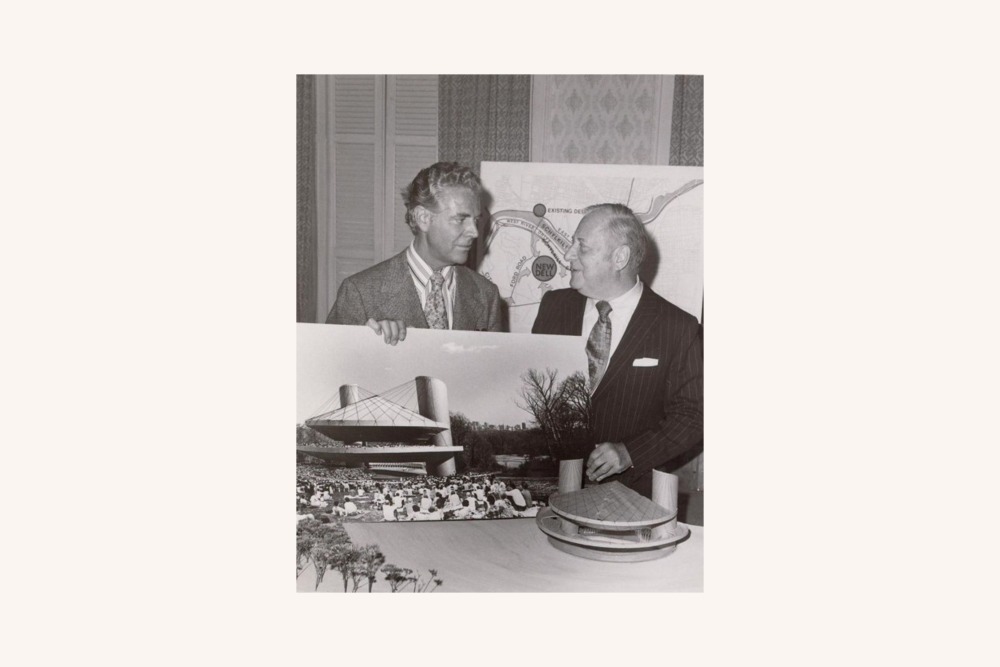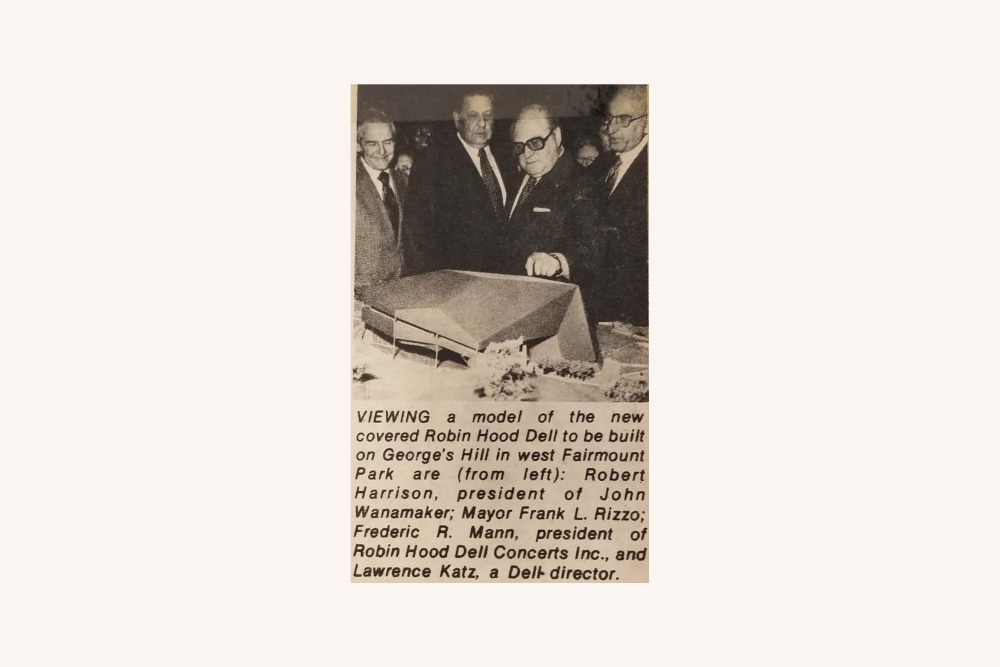From The Vault: Robin Hood Dell West – A Tale of Two Architects
MANN MUSIC ROOM: VAULT
Blog Entry by Jack McCarthy, Historian, The Mann Center for the Performing Arts
The Mann Center traces its history to the Robin Hood Dell, which opened in 1930 in East Fairmount Park as a summer home for The Philadelphia Orchestra. In 1976 the organization moved to a new venue in West Fairmount Park. Originally called Robin Hood Dell West, it was later renamed the Mann Music Center in honor of its longtime director and benefactor Frederic Mann, and subsequently renamed the Mann Center for the Performing Arts.
On January 29, 1975, Philadelphians got their first look at the design for the long-awaited Robin Hood Dell West when a scale model of the new venue was unveiled in the Grand Court at John Wanamaker’s department store in Center City. However, the design of the new facility, scheduled to open eighteen months later, was not the work of noted Philadelphia architect Vincent Kling, who had been the original architect on the project, but that of a New York firm that specialized in outdoor concert venues.
The original Robin Hood Dell, which opened in 1930 in East Fairmount Park, had served concert goers well but had two major problems: the weather and traffic noise. As a completely outdoor venue, the Dell was subject to the whims of Mother Nature, who often wreaked havoc on attendance and scheduling, while the proximity of the Schuylkill Expressway, which opened in 1958, produced constant traffic noise that was a major impediment to the concert experience. By the 1960s, Dell President Frederic Mann was actively seeking to build a new, covered venue in a different location. On May 20, 1971, Mann and Vincent Kling unveiled a model and plans for a modern $9 million facility in West Fairmount Park, with Mann announcing a “vigorous” fundraising campaign to make the venue a reality. Referring to Veterans Stadium, which had just opened in South Philadelphia, Mann said, “If the city can afford a $50 million sports stadium, it can afford $9 million for the arts.”
In many ways, Kling was a natural choice to head up the design of the new Dell West. One of Philadelphia’s most prominent architects at the time, his firm had designed dozens of high-profile buildings and public spaces in and around the city. Among other large-scale projects, he was the principal architect for Penn Center, Centre Square, the US Mint, and the Annenberg Center for the Performing Arts, while his work for the city included the Municipal Services Building, JFK (Love) Park, Dilworth Park, and a major expansion of Philadelphia International Airport. On many of these projects, he worked closely with Philadelphia’s most famous mid-twentieth century architect and planner, Edmund Bacon. Kling was President of the local chapter of the American Institute of Architects and an active member of the Philadelphia Art Commission, in which capacity he weighed in on almost every major architectural and landscape project in the city.
The design that Kling and Mann unveiled for the new Robin Hood Dell West in May 1971 shows a modern, three-tiered structure, with a conical roof supported by cables secured to two massive masonry columns. The cable system allowed for unobstructed views from the different seating levels as well as the lawn area. Eugene Ormandy, longtime music director of The Philadelphia Orchestra, the Dell’s resident ensemble, sent his approval of “the wonderful design” as well as “the selection of the beautiful natural setting.” That setting was not actually where the facility would be built, however. The 1971 proposal had the venue off Chaminoux Drive near Ford Road, about a mile and half north of the George’s Hill area where the Dell West was eventually built.
Kling’s vision for the new Robin Hood Dell was never realized. A little over seven months after his model’s unveiling, Frank Rizzo was sworn in as Mayor of Philadelphia. As part of his promised shake-up of city government, Rizzo targeted Kling (among others), removing him from the Art Commission and publicly questioning Kling’s fees for the airport expansion project, which had been negotiated with the previous administration. Rizzo’s claims of “hanky panky” in the airport deal notwithstanding, an investigation found no wrongdoing on the part of Kling’s firm. Nevertheless, Rizzo vowed that Kling would not receive any future contracts for city projects. This would include the new Robin Hood Dell West, Kling’s plans for which were abandoned.
The architect later chosen for the project was John Hayter MacFadyen of New York, who was exceptionally well-qualified for the task. MacFadyen had recently designed two very successful outdoor concert venues: Saratoga Performing Arts Center in upstate New York, which opened 1966 (and where, coincidentally, The Philadelphia Orchestra had an annual residency), and Wolf Trap Center for the Arts in Virginia, near Washington DC, which opened in 1971. Like Kling, MacFadyen was also active in the arts community, serving in the early 1960s as executive director of the New York State Council on the Arts, and then taking the same position with the Associated Councils on the Arts, a national organization of state and local arts councils.
It was MacFadyen’s design for the new Robin Hood Dell West that Frederic Mann, Frank Rizzo, and other dignitaries proudly unveiled to the public in the Grand Court at John Wanamaker’s on January 29, 1975. Construction of the venue commenced soon thereafter, and it would host its first concert a year and a half later, on June 14, 1976. (For the story of the opening concert and critical reaction to the new venue, see the Opening of the Robin Hood Dell West.)



